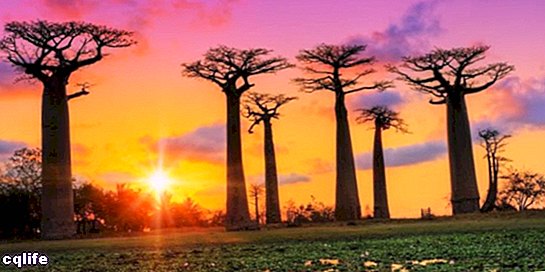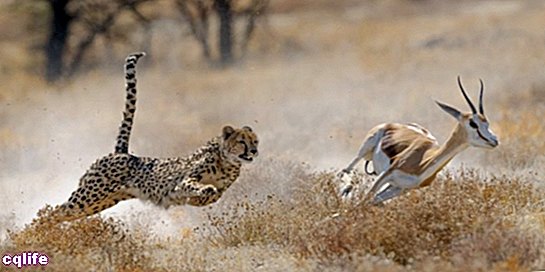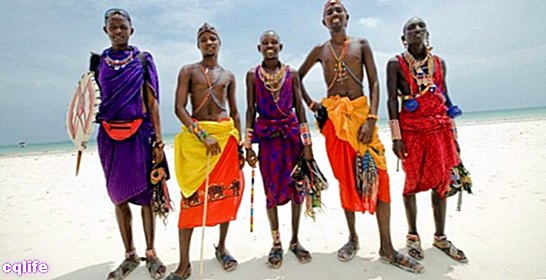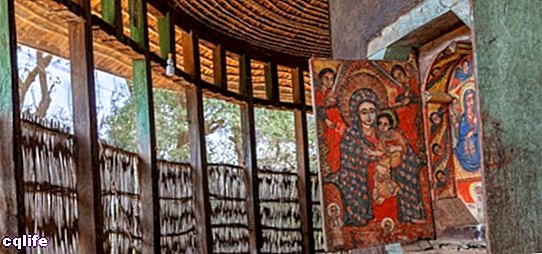- What is Africa?
- Characteristics of Africa
- Flora and fauna of Africa
- Africa climate
- Forms of government in Africa
- Africa population
- Culture of africa
- Political division, countries and capitals of Africa
- Africa's map
- The other continents
We explain everything about Africa, its flora, fauna, climate and other characteristics. In addition, its political division and forms of government.

What is Africa?
Africa is the third largest continent (after Asia Y America). It is bordered in the north by the Mediterranean Sea, in the south by the oceans Indian and Atlantic, in the east with the Red Sea and the Indian Ocean, and in the west with the Atlantic Ocean. It has a total area of 30,272,922 square kilometers, which represents 20% of the total land area of the planet.
The Romans were the first Europeans to have contact with the inhabitants of the African continent, who lived west of the Nile River. The Romans called them "Afri" which derives from the Phoenician language, afar which means "dusty", and ifri which means "cave", something like "cave dwellers."
The strongest theories hold that Africa is the continent from which the Has sapiens (the human being), after successive species of primates (hominids and anthropoids) evolved over millions of years and subsequently migrated from the continent.
Characteristics of Africa

The geography Africa is highlighted by three major deserts: the Sahara (the largest in the world), the Namib and the Kalahari. It presents a long mountainous system in the region east of the continent, the Atlas Mountains, whose highest peak is Kilimanjaro (in Tanzania) with 5,895 meters and which is formed by 3 volcanoes inactive (the Shira, the Mawenzi and the Kibo).
Africa is also highlighted by the Nile River, the largest on the continent and one of the longest in the world. The rest of the rivers have a fairly low flow or are not very navigable. Among its great lakes, the most important are Victoria, Tanganyika, Malawi, Alberto (or Mobutu), Eduardo (Rutanzige) and Kyoga.
Africa has many islands (some are independent nations and others are colonies). The best known is Madagascar, the fourth largest island in the world, located in the southeast on the Indian Ocean and separated from the mainland by the Mozambique Channel.
Formerly most of the African countries were European colonies. At present, despite having become independent, they maintain close economic relations with the European Union. The countries of Africa are underdeveloped and around 350 million people (36% of the population) live on less than US $ 1 a day.
After the United States and the European Union, China is the third most important partner in the continent, with industrial investments destined to the construction of roads, exploitation of hydrocarbons Y minerals, reservoirs, homes and hospitals.
Flora and fauna of Africa

The fauna of Africa includes many wild animals such as leopards and antelopes.
The fauna is characterized by wild animals What lions, zebras, antelopes, elephants, giraffes, cheetahs, buffaloes and hyenas that live in the bed sheet, the biome that predominates on the African continent. For their exotic beauty they are coveted by smugglers and that is why there are numerous organizations Y laws to counter their trafficking and illegal hunting.
The flora of the savannah is made up of the combination of grasslands, shrubs and trees of little density, and palm trees around the oases. The Baobabs tree (typical of the island of Madagascar) stands out, whose leaves, fruits and seeds are used as food, for the Health and for the production of products cosmetics.
Africa climate
The African continent is crossed by the line of the equator that divides it almost into two equidistant halves, so the weather predominant is the tropical.
Libya (a country in North Africa) is the hottest region on the planet, whose temperature It has reached 58º C. At the extremes furthest from the equator, the climate is sub-arctic with arid or desert areas. In the southern region the climate is temperate, warmer and more humid.
Forms of government in Africa

More than half of the state Africans are characterized by being authoritarian (only a small part is democratic). According to the form of government, the countries can be classified into:
- Authoritarian governments. There are 28 authoritarian countries: Angola, Algeria, Burundi, Cameroon, Chad, Comoros, Egypt, Eritrea, Ethiopia, Gabon, Guinea, Equatorial Guinea, Guinea-Bissau, Libya, Mauritania, Mozambique, Niger, Central African Republic, Republic of the Congo, Democratic Republic of the Congo, Rwanda, Somalia, Swaziland, Sudan, South Sudan, Togo, Djibouti and Zimbabwe.
- Hybrid governments. There are 15 hybrid countries: Benin, Burkina Faso, Ivory Coast, Gambia, Iberia, Kenya, Madagascar, Malawi, Mali, Morocco, Sierra Leone, Nigeria, Tanzania, Uganda and Zambia.
- Democratic governments. There are 11 democratic countries: Botswana, Cape Verde, Ghana, Lesotho, Mauritius, Namibia, São Tomé and Príncipe, Senegal, Seychelles, South Africa and Tunisia.
Africa population

The population of Africa is 1.2 billion people (equivalent to 15% of the total human population) and is made up of various ethnic groups and tribes such as the Bushmen, the Maasai, the Pygmies and the Hottentots. Nigeria is the most populous and poorest African country on the continent (and the planet).
The town Luanda (the capital of Angola) is one of the most expensive cities in the world, even more than Tokyo (Japan) or Geneva (Switzerland). However, 2/3 of the African population lives below the threshold of poverty and, of the total number of out-of-school children in the world, 43% are African.
Culture of africa

Africans practice a wide variety of religions traditional. Islam predominates in the northern regions and, from the 20th century, Catholicism and Protestantism acquired great prominence. Religious rituals are characterized by being accompanied by music with drums, to invoke the different deities (the rhythm varies depending on the god they are addressing).
There are more than 3,000 tribes or native peoples that continue to maintain traditions ancestral, even today rituals of ablation of female intimate parts are practiced, despite being considered a violation of the human rights by UN (United Nations).
Political division, countries and capitals of Africa
Africa is divided into 54 sovereign states (51 constituted as a republic and 3 constituted as a monarchy), 2 states with limited recognition and 2 independent territories:
The sovereign countries of Africa are:
- Angola. Capital: Luanda
- Algeria. Capital: Algiers
- Benin Capital: New Porto and Cotonou
- Botswana. Capital: Gaborone
- Burkina Faso. Capital Ouagadougou
- Burundi. Capital: Gitega
- Cape Verde. Capital: Praia
- Cameroon. Capital: Yaoundé
- Chad. Capital: N'Djamena
- Comoros. Capital: Moroni
- Ivory Coast. Capital: Yamoussoukro
- Egypt. Capital: Cairo
- Ethiopia. Capital: Addis Ababa
- Gabon. Capital: Libreville
- Gambia. Capital: Banjul
- Ghana. Capital: Accra
- Guinea. Capital: Conakry
- Guinea-Bissau. Capital: Bissau
- Equatorial Guinea. Capital: Malabo
- Kenya. Capital: Nairobi
- Lesotho. Capital: Maseru
- Liberia. Capital: Monrovia (monarchy)
- Libya. Capital: Tripoli
- Madagascar. Capital: Antananative
- Malawi. Capital: Lilongwe
- Mali. Capital: Bamako
- Morocco. Capital: Rabat (monarchy)
- Mauricio. Capital: Port Louis
- Mauritania. Capital: Nouakchott
- Mozambique. Capital: Maputo
- Namibia. Capital: Windhoek
- Niger. Capital: Niamey
- Nigeria. Capital: Abuja
- Central African Republic. Capital: Bangui
- Republic of Congo. Capital: Brazaville
- Democratic Republic of Congo. Capital: Kinsasa
- Rwanda. Capital: Kigali
- Sao Tome and Principe. Capital: São Tomé
- Senegal. Capital: Dakar
- Seychelles. Capital: Victoria
- Sierra Leone. Capital: Freetown
- Somalia. Capital: Mogadishu
- Swaziland. Capital: Babane and Lobamba (monarchy)
- South Africa. Capitals: Bloemfontein (judicial capital), Cape Town (legislative city) and Pretoria (administrative capital).
- Sudan. Capital: Khartoum
- South Sudan. Capital: Yuba
- Tanzania. Capital: Dodoma
- Togo. Capital: Lomé
- Tunisia. Capital: Tunis
- Uganda. Capital: Kampala
- Djibouti. Capital: Djibouti
- Zambia. Capital: Lusaka
- Zimbabwe. Capital: Harare
African Limited Recognition States are:
- Sahrawi Arab Democratic Republic. Capital: Laayoune
- Somaliland. Capital: Hargeisa
The independent states of Africa are:
- Santa Elena, Ascensión and Tristán de Acuña (depends on the United Kingdom). Capital: Jamestown
- French Southern and Antarctic Lands (dependent on France). Capital: Saint-Pierre
Africa's map
The other continents
The continents of the planet are 6 in total: Africa, America, Europe, Asia, Oceania and Antarctica (the southernmost, with a population of approximately 4,000 inhabitants in summer and 1,000 in winter).
Africa is the third largest continent, after Asia and America. It borders to the north with the European continent (from which the Mediterranean Sea separates it) and to the east with the Asian continent (from which it is separated by the Suez Canal, through which the Red Sea passes).
